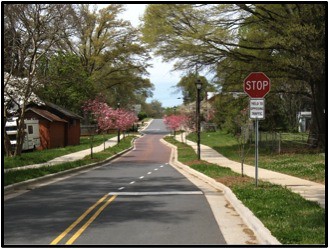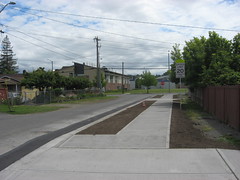
News
By Stefanie Seskin, July 5, 2010

As July unfolds before us – and we in Washington, DC attempt to acclimate to its accompanying heat and humidity – we’re looking back on the progress of the Complete Streets movement since the year began.
We’ve had incredible progress on Complete Streets at the national level. In February, the Department of Transportation awarded millions for dollars through its $1.5 billion discretionary grant program (TIGER) to create complete streets across the country. The next month, Transportation Secretary Ray LaHood announced a new US DOT policy statement that calls for full inclusion of pedestrians and bicyclists in transportation projects, with particular attention paid to transit riders and people of all ages and abilities. (We recently joined America Bikes, Transportation for America, and the Safe Routes to School National Partnership at an event to personally thank Secretary LaHood for his leadership.)
The role of Complete Streets in both health and transportation policy is more clear than ever. In the Centers for Disease Control and Prevention’s recommendations for federal transportation policy, almost all of the key strategies and policies related to Complete Streets. Complete Streets were also included in the National Physical Activity Plan and the White House Task Force’s “Let’s Move!” action plan.
Finally, we’ve added even more cosponsors onto the Complete Streets Act of 2009: 14 in the House and 2 in the Senate. If your Members of Congress haven’t cosponsored the bill yet, ask them to support Complete Streets today! If they’re already cosponsors, be sure to thank them for their support.
Two states – Minnesota and Colorado – have adopted Complete Streets requirements into their state statutes. Legislation has been introduced in six other state legislatures: Indiana, Michigan, New York, Vermont, Washington, and West Virginia. Michigan’s House passed their complete streets bills just a few days ago, and they now move on to the Senate. In New York, the State Senate passed strong legislation, but the companion Assembly bill still needs to move out of one more committee before heading to a full vote.
On a more local scale, policies have been adopted in 18 jurisdictions since January, including the first policies in Mississippi (in Tupelo and Hernando), a strong regional policy in the Columbus, Ohio area, and ordinances in Salt Lake City and Salt Lake County, Utah. Countless campaigns have been launched in communities as diverse as Huntsville, Alabama and Anchorage, Alaska.

We’ve held 9 Complete Streets workshops, helping communities from Tacoma, Washington to Omaha, Nebraska move ahead in achieving their complete streets goals. Our instructors also participated in the Communities Putting Prevention to Work “Action Institutes,” sharing their knowledge with diverse teams of decision makers looking to enact policies with long-term health benefits.
Lessons from communities informed the content of one of our biggest publications to date: Complete Streets: Best Policy and Implementation Practices, published by the American Planning Association a few months ago. Perhaps the most inspiring theme in the publication is the way that Complete Streets policies have empowered planners and engineers to tackle a new challenge with creativity and innovation.
Since January 1, we’ve witnessed so much of that innovation that enables our movement to thrive. We can’t wait to see what happens in the next six months.
Related News

© 2025 Smart Growth America. All rights reserved
Site By3Lane Marketing












